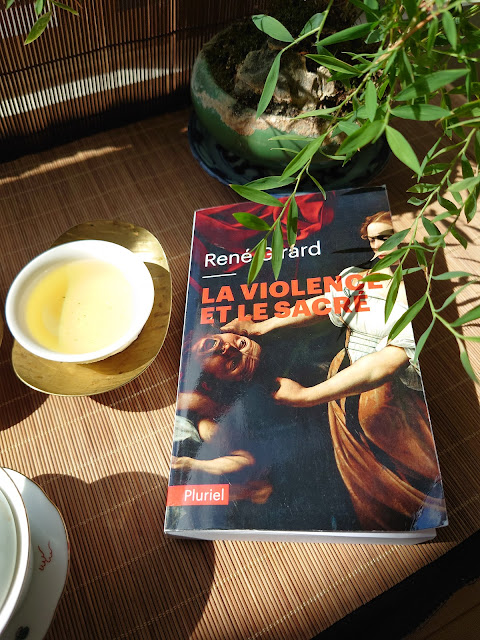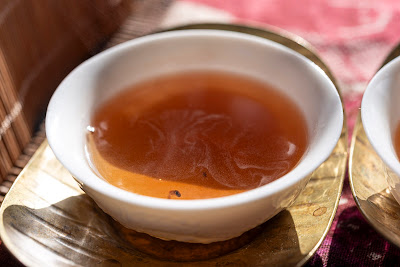My article about the meaning of wine in the Odyssey by Homer attracted a larger number of readers than I anticipated. It seems that the subject of 'Violence and the sacred' (the book of René Girard) interests you. I will summarize what I learned and how it applies to all ceremonies (including tea!) Indeed, to call a tea preparation a 'tea ceremony' shows that we wish to give it a more profound meaning. The name 'tea ceremony' is somewhat controversial. Not everyone likes to call it such. Those who do seem to choose a religious approach, or is it more a sect since it isn't directly affiliated with a great religion?
I'll try to make better sense of it thanks to the findings of René Girard. He studied the religion and myths of many archaic societies and realized that there are common patterns for all their ceremonies, their deities all over the world. Of course, there are also differences, but he found the similarities more amazing and focused on them. From these ceremonies, he deducted a dark origin of violence in all primitive societies.
The fuel for the violence is humans' natural tendency to have
mimetic desires. So, according to Girard, in primitive human societies, religions started as a response to a mimetic crisis. This crisis usually starts with siblings or twins who desire the same object. Since they are of the same age and very similar strength and skill, they are unlikely to yield to the other. Their feud extends to the whole tribe as violence becomes contagious and all tribesmen join one side or the other. The violence stops when both sides eventually agree to designate a culprit, which we moderns call a scapegoat. The violence can also be started by a natural catastrophe (flooding, cold, heat...) as it would reduce the amount of food available, which would cause resentment between those who have enough and those who don't have enough.
 |
| Oriental Beauty, summer 2023 |
Girard makes the case that primitive religions are a step towards a more peaceful society. The etymology of the word 'religion' comes from "re' again and 'ligare': to bind together. It means a religion is what binds a society together after it was set loose (by violence!).

The ceremonies of primitive religions tend to symbolically recreate the violent crisis and its peaceful conclusion. The large gathering of all members of the society is preferable as it mimics the original crisis. Then, the former culprit is worshiped, because he's the one who has brought peace. Sacrifices are made to him to keep him content. The power of the ceremony to keep the community united usually weakens with time. People tend to forget how terrible the original crisis was. The unstated goal of the ceremonies is to remind us of the perils of violence and to unite us by giving us a good feeling of belonging to the community. That's why most ceremonies end with a party, a feast. However, the beginning of the ceremony can be very tense, requiring our utmost attention in order to perform the rites properly. Any mistake could bring bad luck or the wrath of the deity.

This, in a nutshell, is how all archaic ceremonies work. Modern ceremonies are often built on some aspects of these ancient rites. Let's examine how tea ceremonies draw from ancient ones.
1. The symbolic sacrifice is the tea. The better. the more famous or the more expensive the leaves, the more likely is the ceremony to become successful!
2. The more guests are in attendance and the more important they are, they better the tea should be in order to satisfy the crowd! A rare and old tea is really sacrificed, since it can't be replaced. Like deities, we feel honored when a rare and cherished tea is brewed for us.
3. A tea prepared by a top tea master indicates that the ceremony is very serious, solemn. If a tea student is preparing the tea, then we can all be more relaxed about it. Mistakes are tolerated from the students, but not from the master.
4. A good tea ceremony is one where you combine respect, quiet, peace from the attendants, skill by the tea master to honor the tea and the guests. The goal is that the delicious tea make everybody feel happy, peaceful and experience a common pleasure that will reinforce the social bonds among the guests.
5. The symbols used during the tea ceremony are there to create harmony on multiple levels and ensure the success of the event.
Conclusion: as we scratch the surface of a tea ceremony, we find that it works like the ceremony of an archaic religion in my ways. I'm sure you'll come up with more similarities. However, this also shows that a casual tea or a tea that is drunk alone can't be deemed a tea ceremony. At least, it has to be shared virtually in order to touch the feelings of other tea fans!
 |
| Oriental Beauty from Hsin Chu, summer 2023 |















No comments:
Post a Comment